Laboratory Experiment on Formation of MICP Horizontal Seepage-Reducing Body in Confined Aquifer for Deep Excavation
Abstract
:1. Introduction
2. Materials and Methods
2.1. Materials
2.1.1. Preparation of Bacterial Solution
2.1.2. Cementation Solution
2.1.3. Sand Samples
2.2. Experimental Study on Dynamic Adsorption Characteristics of Solute
- (1)
- Adsorption kinetics of S. pasteurii
- (2)
- Adsorption kinetics of CaCl2 solution
- (3)
- Adsorption kinetics of urea solution
2.3. Experimental Study on Isothermal Adsorption Characteristics of Solute
- (1)
- Isothermal adsorption test of S. pasteurii
- (2)
- Isothermal adsorption test of CaCl2
2.4. Dispersity Sand Column Test
3. Results and Discussion
3.1. Experimental Study on Dynamic Adsorption Characteristics of Solute
3.1.1. Results of Adsorption Kinetics Test of S. pasteurii
3.1.2. Results of Adsorption Kinetics of CaCl2 Solution
3.1.3. Results of Adsorption Kinetics of Urea Solution
3.2. Experimental Study on Isothermal Adsorption Characteristics of Solute
3.2.1. Isothermal Adsorption Test of S. pasteurii
3.2.2. Isothermal Adsorption Test of CaCl2
3.3. Dispersity Sand Column Test
4. Conclusions
Author Contributions
Funding
Institutional Review Board Statement
Conflicts of Interest
References
- Cao, C.Y.; Shi, C.H.; Peng, L.M.; Jiang, S.G.; Liu, S.L.; Liu, J.W. Design method and application of horizontal bottom sealing curtains for deep foundation pits excavated in deep aquifers with high permeability. J. Cent. South Univ. Sci. Technol. 2020, 51, 1012–1021. [Google Scholar] [CrossRef]
- Cao, S.H.; Che, C.H.; Ji, Y.A. Application of Deep Horizontal Bottom Sealing to Groundwater Control of Foundation Pit with Super-thick Sand and Pebble Layer. Tunn. Constr. 2019, 39, 1657–1665. [Google Scholar] [CrossRef]
- Zhang, Z.X.; Li, J.Y. Summary and application of MJS foundation treatment technology. Civil Archit. Environ. Eng. 2017, 6, 1. [Google Scholar]
- Qian, C.X.; Wang, A.H.; Wang, X. Advances of soil improvement with bio-grouting. Rock Soil Mech. 2015, 36, 1537–1548. [Google Scholar] [CrossRef]
- Chang, I.; Im, J.; Cho, G.C. Introduction of microbial biopolymers in soil treatment for future environmentally-friendly and sustainable geotechnical engineering. Sustainability 2016, 8, 251. [Google Scholar] [CrossRef] [Green Version]
- Márcia, A.S.; Katia, K.K.; Vanderley, M.J.; Henrique, K.; Marcos, M.F. Sand bioconsolidation through the precipitation of calcium carbonate by two ureolytic bacteria. Mater. Lett. 2011, 65, 1730–1733. [Google Scholar] [CrossRef]
- Martinez, B.C.; DeJong, J.T.; Ginn, T.R.; Montoya, B.M.; Barkouki, T.H.; Hunt, C.; Tanyu, B.; Major, D. Experimental Optimization of Microbial-Induced Carbonate Precipitation for Soil Improvement. J. Geotech. Geoenviron. Eng. 2013, 139, 587–598. [Google Scholar] [CrossRef]
- Aamir, M.; Abdelmalek, B.; Will, P.G. Unconfined compressive strength and visualization of the microstructure of coarse sand subjected to different Biocementation levels. J. Geotech. Geoenviron. Eng. 2019, 145, 04019033. [Google Scholar] [CrossRef]
- Azadi, M.; Ghayoomi, M.; Shamskia, N.; Kalantari, H. Physical and mechanical properties of reconstructed bio-cemented sand. Soils Found. 2017, 57, 698–706. [Google Scholar] [CrossRef]
- Ashraf, M.S.; Azahar, S.B.; Yusof, N.Z. Soil improvement using MICP and biopolymers: A review. IOP Conf. Ser. Mater. Sci. Eng. 2017, 226, 22612058. [Google Scholar] [CrossRef]
- Pitcha, J.; Janprasit, K.; Nuaklong, P.; Pungrasmi, W.; Likitlersuang, S. Investigation of the crack healing performance in mortar using microbially induced calcium carbonate precipitation (MICP) method. Constr. Build. Mater. 2019, 212, 737–744. [Google Scholar] [CrossRef]
- Zhu, X.J.; Li, W.L.; Zhan, L.; Huang, M.S.; Zhang, Q.Z.; Achal, V. The large-scale process of microbial carbonate precipitation for nickel remediation from an industrial soil. Environ. Pollut. 2016, 219, 149–155. [Google Scholar] [CrossRef] [PubMed]
- Liu, B.; Zhu, C.; Tang, C.S.; Xie, Y.H.; Yin, L.Y.; Cheng, Q.; Shi, B. Bio-remediation of desiccation cracking in clayey soils through microbially induced calcite precipitation (MICP). Eng. Geol. 2020, 264, 264105389. [Google Scholar] [CrossRef]
- Van Tittelboom, K.; De Belie, N.; De Muynck, W.; Verstraete, W. Use of bacteria to repair cracks in concrete. Cem. Concr. Res. 2010, 40, 157–166. [Google Scholar] [CrossRef]
- Castanier, S.; Metayer-Levrel, G.L.; Perthuisot, J.P. Ca-carbonates precipitation and limestone genesis-the microbiogeologist point of view. Sediment. Geol. 1999, 126, 9–23. [Google Scholar] [CrossRef]
- Zhao, Q.; Li, L.; ASCE, M.; Li, C.; Li, M.; Amini, F.; ASCE, F.; Zhang, H.Z. Factors Affecting Improvement of Engineering Properties of MICP-Treated Soil Catalyzed by Bacteria and Urease. J. Mater. Civ. Eng. 2014, 26, 04014094. [Google Scholar] [CrossRef]
- Baskar, S.; Baskar, R.; Mauclaire, L.; McKenzie, J.A. Microbially induced calcite precipitation in culture experiments: Possible origin for stalactites in Sahastradhara caves, Dehradun. India. Curr. Sci. 2006, 90, 58–64. [Google Scholar]
- Bachmeier, K.L.; Williams, A.E.; Warmington, J.R.; Bang, S.S. Urease activity in microbiologically-induced calcite precipitation. J. Biotechnol. 2002, 93, 171–181. [Google Scholar] [CrossRef]
- Mondal, S.; Ghosh, A. Review on microbial induced calcite precipitation mechanisms leading to bacterial selection for microbial concrete. Constr. Build. Mater. 2019, 225, 67–75. [Google Scholar] [CrossRef]
- Kim, G.; Kim, J.; Youn, H. Effect of Temperature, pH, and Reaction Duration on Microbially Induced Calcite Precipitation. Appl. Sci. 2018, 8, 1277. [Google Scholar] [CrossRef] [Green Version]
- Stabnikov, V.; Jian, C.; Ivanov, V.; Li, Y.S. Halotolerant, alkaliphilic urease-producing bacteria from different climate zones and their application for biocementation of sand. World J. Microbiol. Biotechnol. 2013, 29, 1453–1460. [Google Scholar] [CrossRef] [PubMed]
- Jiang, N.J.; Tang, C.S.; Yin, L.Y.; Xie, Y.H.; Shi, B. Applicability of microbial calcification method for sandy-slope surface erosion control. J. Mater. Civ. Eng. 2019, 31, 04019250. [Google Scholar] [CrossRef]
- Yates, M.V.; Yates, S.R.; Wagner, J.; Gerba, C.P. Modeling virus survival and transport in the subsurface. J. Contam. Hydrol. 1987, 1, 329–345. [Google Scholar] [CrossRef]
- Dai, C.M.; Zhou, H.; Liu, S.G.; Tan, B.; Wan, Y.Q. Review on research on co-transport of contaminants and colloids in the porous media of groundwater. J. Water Resour. Water Eng. 2017, 28, 15–23. [Google Scholar] [CrossRef]
- Sen, T.K.; Khilar, K.C. Review on subsurface colloids and colloid-associated contaminant transport in saturated porous media. Adv. Colloid Interface Sci. 2006, 119, 71–96. [Google Scholar] [CrossRef]
- Schijven, J.F.; Hassanizadeh, S.M.; Dowd, S.E.; Pillai, S.D. Modeling virus adsorption in batch and column experiments. Quant. Microbiol 2000, 2, 5–20. [Google Scholar] [CrossRef]
- Sadeghi, G.; Schijven, J.F.; Behrends, T.; Hassanizadeh, S.M.; Genuchten, M.T. Bacteriophage PRD1 batch experiments to study attachment, detachment and inactivation processes. J. Contam. Hydrol. 2013, 152, 12–17. [Google Scholar] [CrossRef]
- Bhattacharjee, S.; Ryan, J.N.; Elimelech, M. Virus transport in physically and geochemically heterogeneous subsurface porous media. J. Contam. Hydrol. 2002, 57, 161–187. [Google Scholar] [CrossRef]
- Bradford, S.A.; Bettahar, M. Straining, attachment, and detachment of Cryptocysts in saturated porous media. J. Environ. Qual. 2005, 34, 469–478. [Google Scholar] [CrossRef]
- Bart, F.; Dimitri, V. A systematic approach to in situ bioremediation in groundwater. Remediation 2003, 13, 27–52. [Google Scholar] [CrossRef]
- Foppen, J.W.A.; Schijven, J.F. Evaluation of data from the literature on the transport and survival of Escherichia coli and thermotolerant coliforms in aquifers under saturated conditions. Water Res. 2006, 40, 401–426. [Google Scholar] [CrossRef] [PubMed] [Green Version]
- McClellan, K. A New Approach to Groundwater Remediation Treatability Studies-Moving Flow-through Column Experiments from Laboratory to In Situ Operation. Ph.D. Thesis, Arizona State University, Tempe, AZ, USA, 2013. [Google Scholar]
- Zhao, B.; Zhang, H.; Zhang, J.; Jin, Y. Virus adsorption and inactivation in soil as influenced by autochthonous microorganisms and water content. Soil Biol. Biochem. 2008, 40, 649–659. [Google Scholar] [CrossRef]
- Jiang, G.M.; Noonan, M.J.; Buchan, G.D.; Smith, N. Transport of Escherichia coli through variably saturated sand columns and modeling approaches. J. Contam. Hydrol. 2007, 93, 2–20. [Google Scholar] [CrossRef] [PubMed]
- Treumann, S.; Torkzaban, S.; Bradford, S.A.; Visalakshan, R.M.; Page, D. An explanation for differences in the process of colloid adsorption in batch and column studies. J. Contam. Hydrol. 2014, 164, 219–229. [Google Scholar] [CrossRef]
- Abo-El-Enein, S.A.; Ali, A.H.; Talkhan, F.N.; Abdel-Gawwad, H.A. Utilization of microbial induced calcite precipitation for sand consolidation and mortar crack remediation. Hbrc J. 2012, 8, 185–192. [Google Scholar] [CrossRef] [Green Version]
- Achal, V.; Pan, X. Influence of calcium sources on microbially induced calcium carbonate precipitation by Bacillus sp. CR2. Appl. Biochem. Biotechnol. 2014, 173, 307–317. [Google Scholar] [CrossRef] [PubMed]
- Tang, C.S.; Yin, L.Y.; Jiang, N.J.; Zhu, C.; Zeng, H.; Li, H.; Shi, B. Factors affecting the performance of microbial-induced carbonate precipitation (MICP) treated soil: A review. Environ. Earth Sci. 2020, 79, 1–23. [Google Scholar] [CrossRef]
- Ramachandran, S.K.; Ramakrishnan, V.; Bang, S.S. Remediation of concrete using microorganisms. ACI Mater. J 2001, 98, 3–9. [Google Scholar]
- Jacobs, A.; Lafolie, F.; Herry, J.M.; Debroux, M. Kinetic adhesion of bacterial cells to sand: Cell surface properties and adhesion rate. Colloids Surf. B-Biointerfaces 2007, 59, 35–45. [Google Scholar] [CrossRef] [PubMed]
- Marshall, K.C.; Ruby, S.; Ralph, M. Selective sorption of bacteria from seawater. Can. J. Microbiol. 1971, 17, 1413–1416. [Google Scholar] [CrossRef]
- Vanoss, C.J. Energetics of cell-cell and cell bio-polymer interactions. Cell Biophys. 1989, 14, 1–16. [Google Scholar] [CrossRef] [PubMed]
- Arpita, M.; Shrey, M.; Suchismita, R.; Arpita, P.; Shrabani, P.; Koushik, D.; Tanmay, P.; Keshab, C.M.; Dilip Kumar, N. Assessment of efficacy of a potential probiotic strain and its antiuremic and antioxidative activities. e-SPEN J. 2013, 8, 155–163. [Google Scholar] [CrossRef]
- Neuman, S.P.; Zhang, Y.K. A quasi-liner theory of non-Fickian and Fickian subsurface dispersion, 1. Theoretical analysis with application to isotropic media. Water Resour. Res. 2010, 26, 887–902. [Google Scholar] [CrossRef]
- Xu, M.; Eckstein, Y. Use of weighted leastsquares method in evaluation of the relationship between dispersivity and field scale. Ground Water. 1995, 33, 905–908. [Google Scholar] [CrossRef]


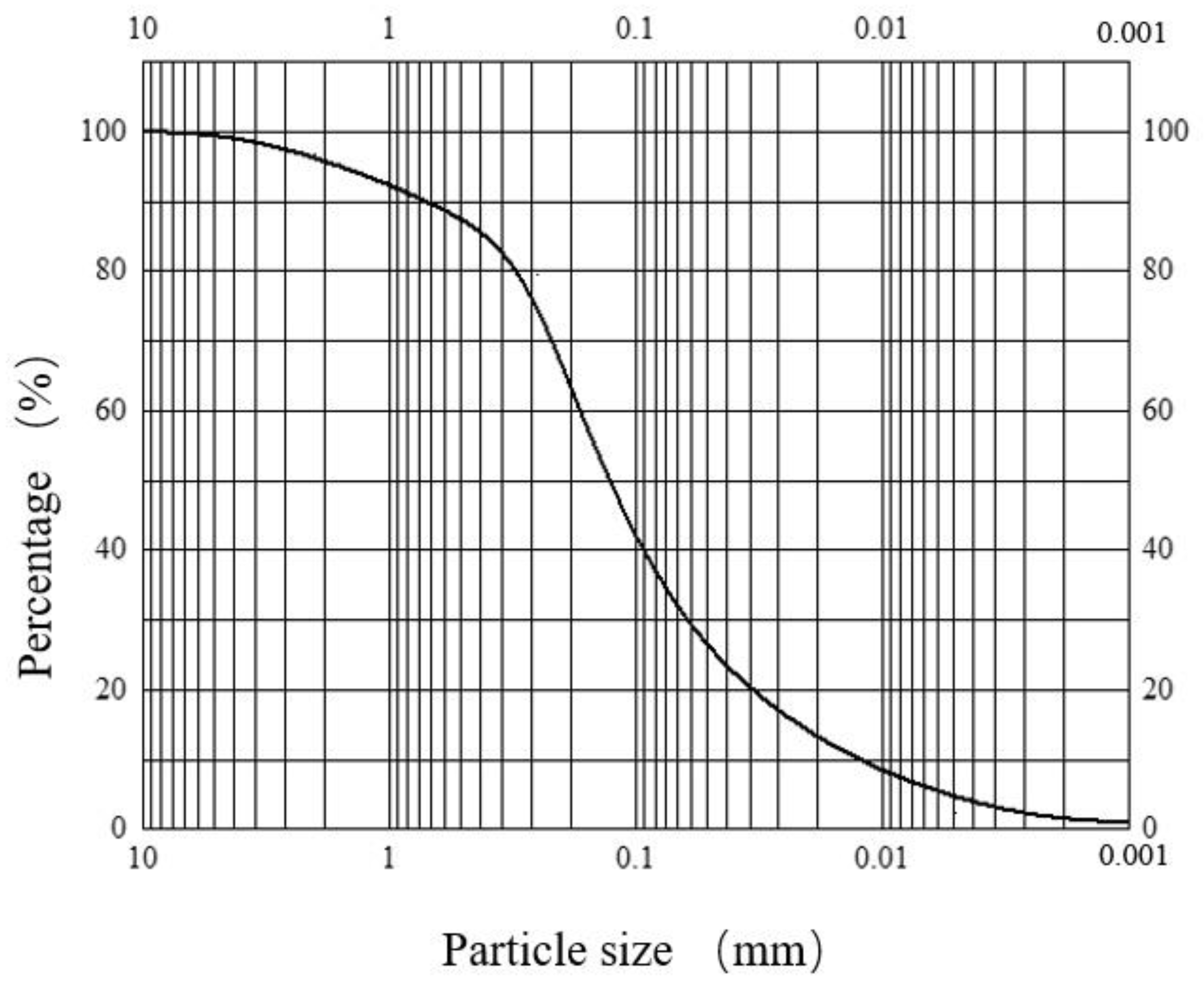

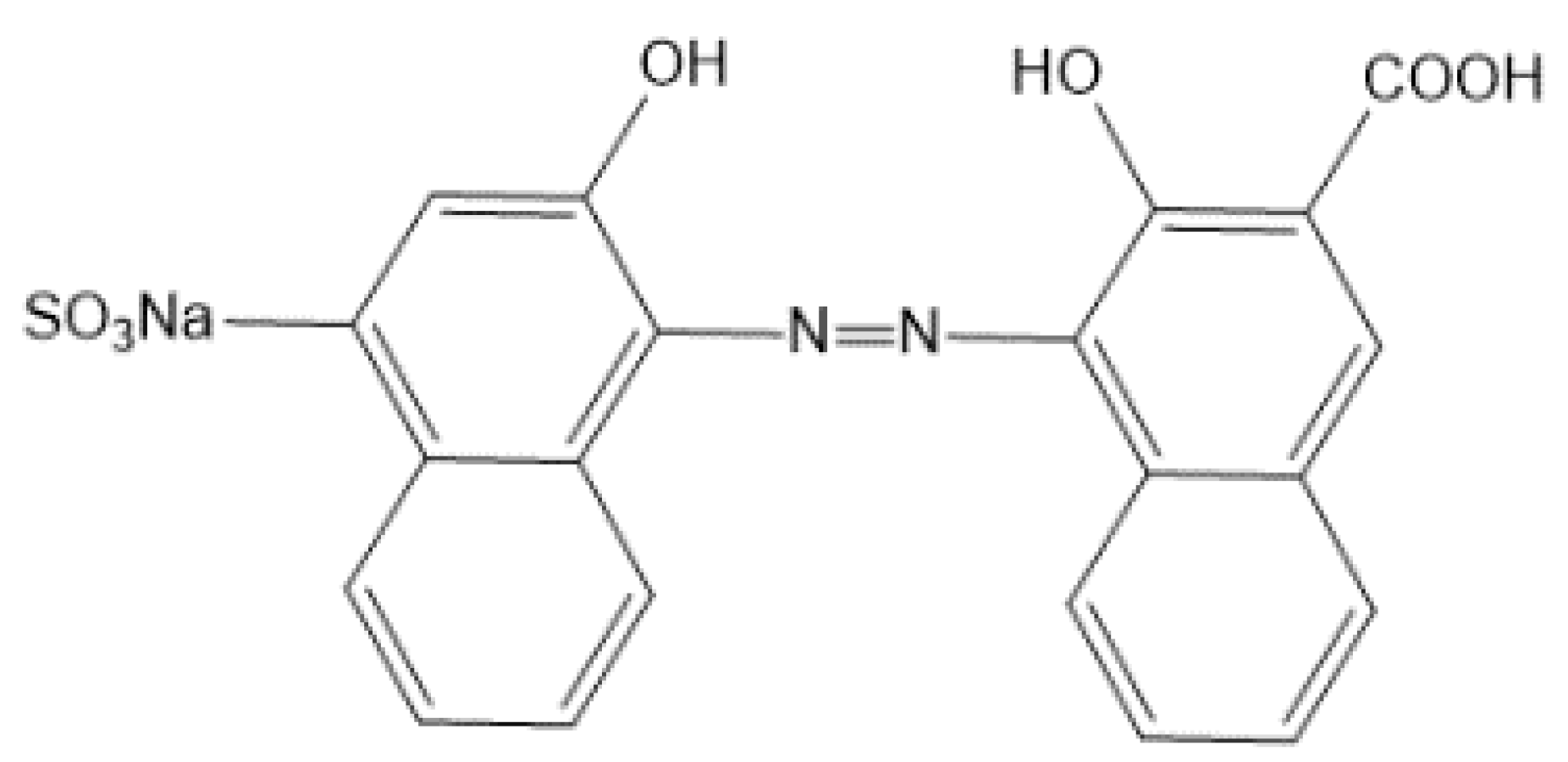

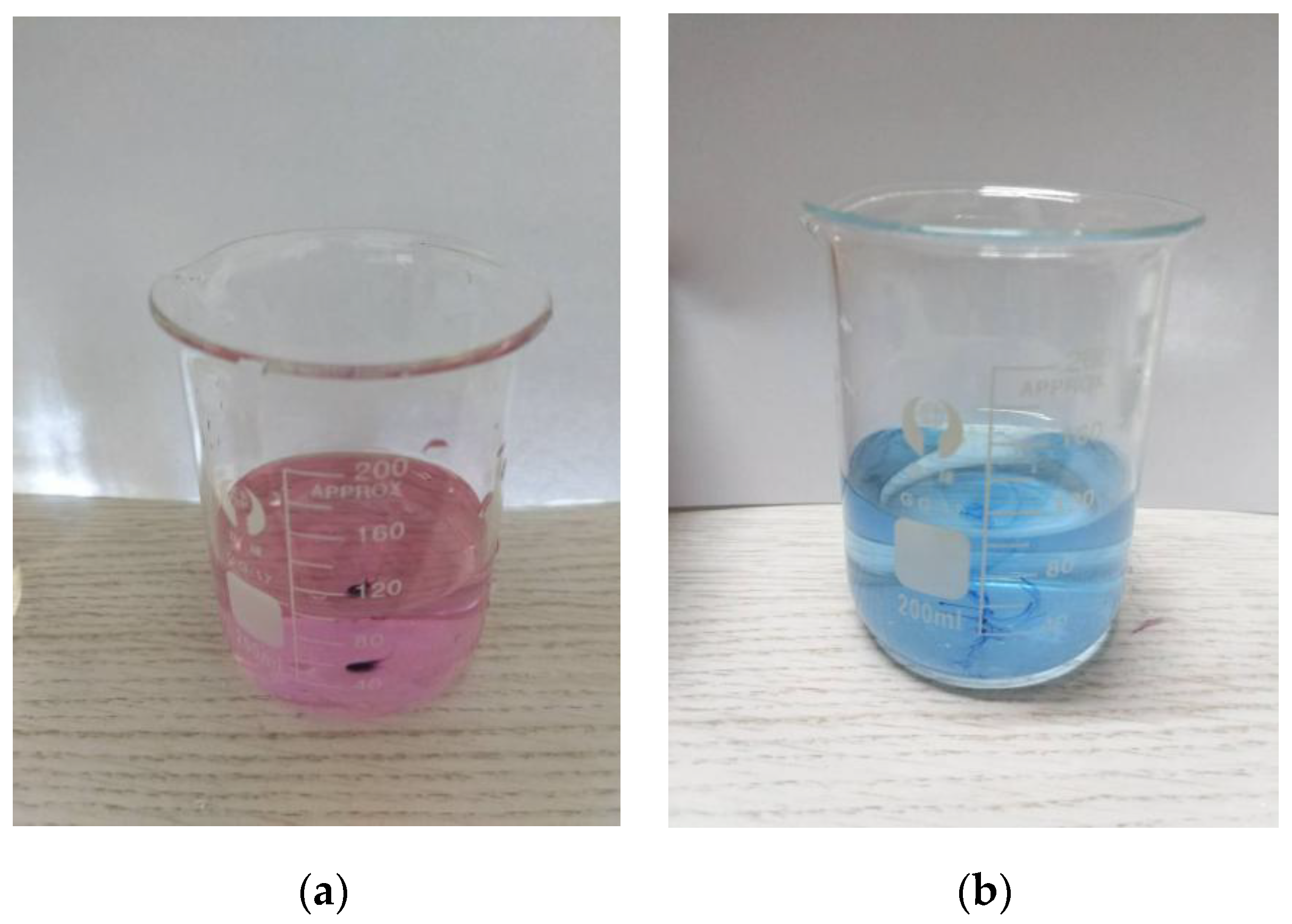
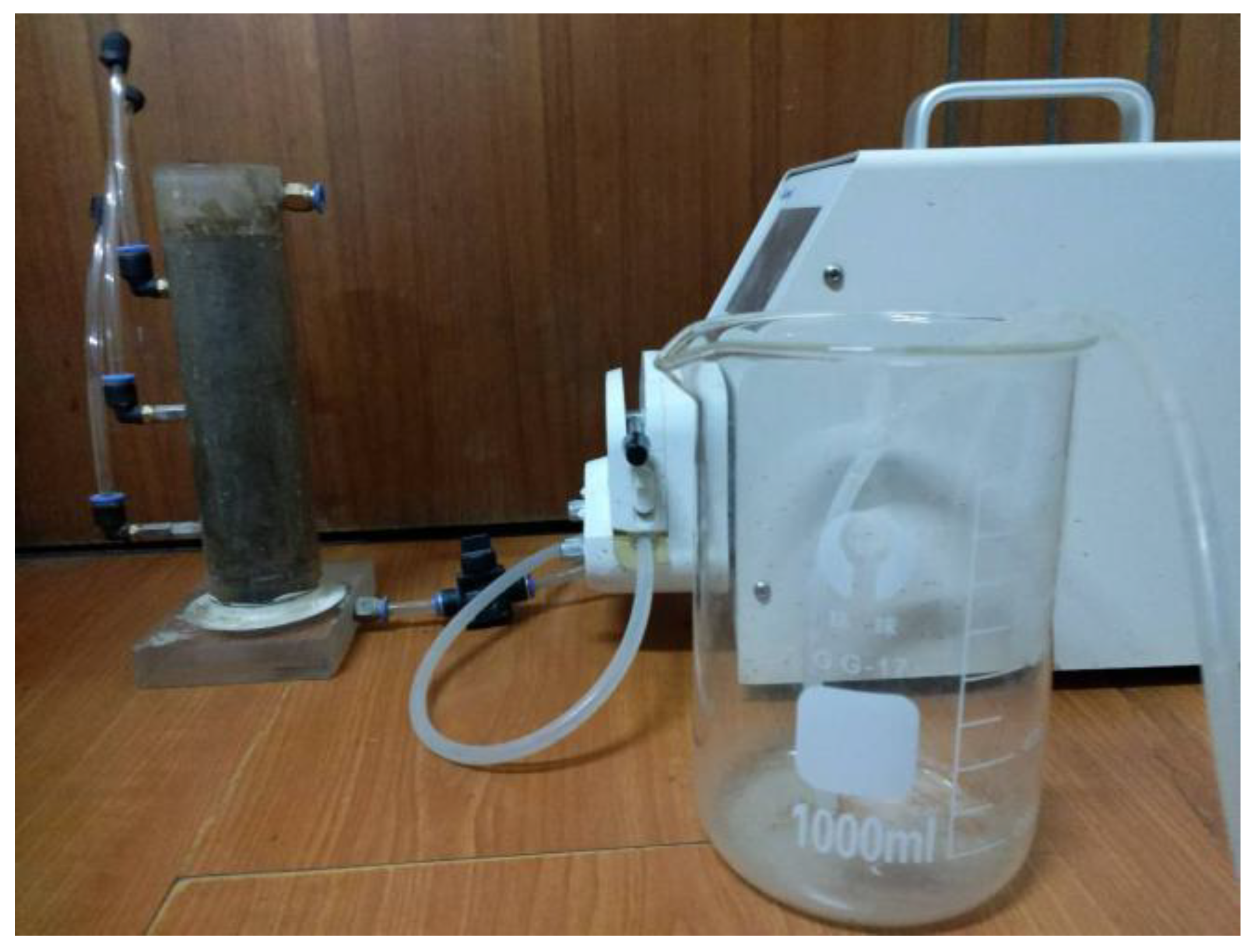

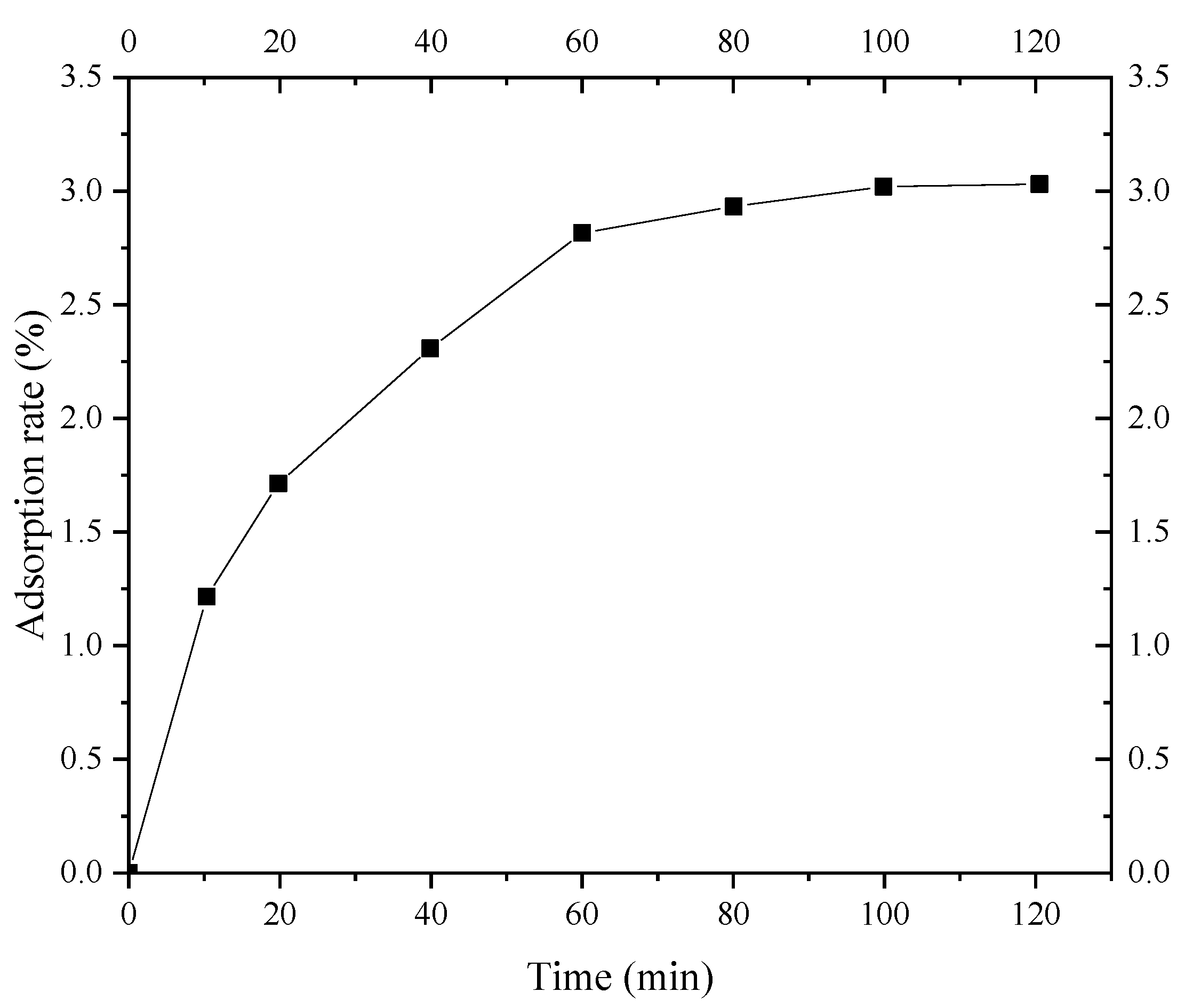
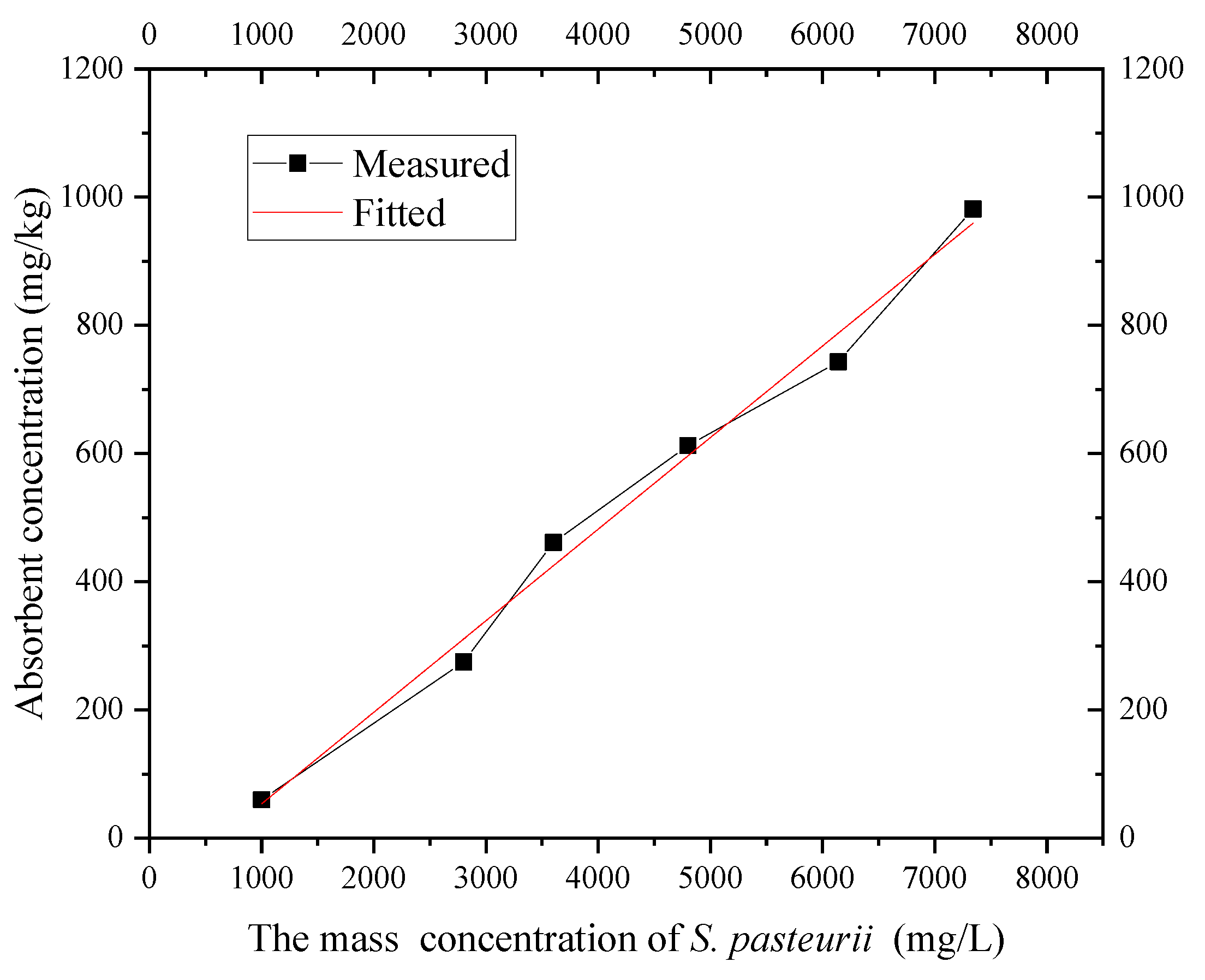
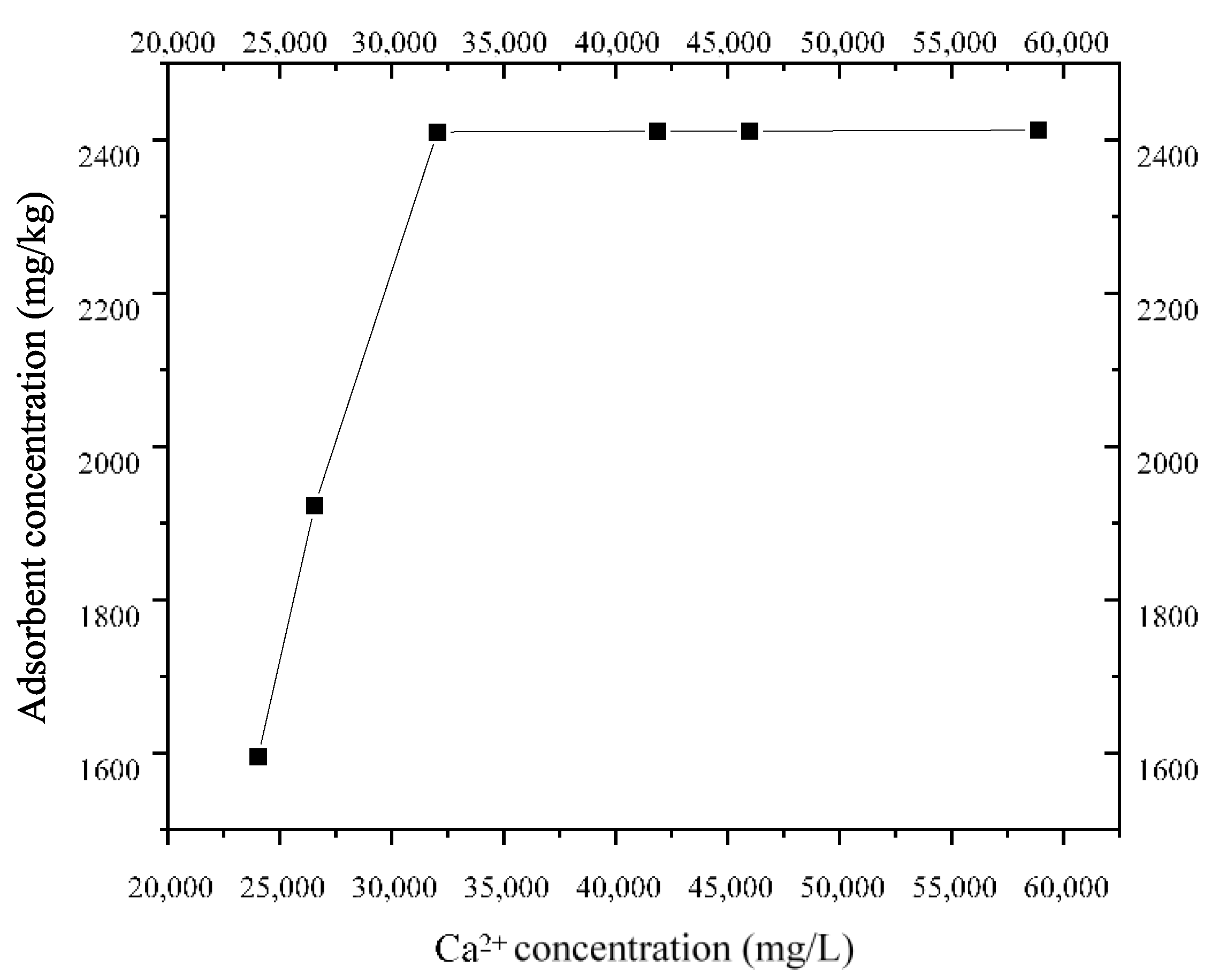

| Isotherm Type | Freundlich Isotherm | |
|---|---|---|
| Parameter | R2 | (L/mg) |
| Value | 0.9903 | 1.5 × 10−7 |
| Isotherm Type | Linear Isothermal Adsorption | Langmuir | ||
|---|---|---|---|---|
| Parameter | R2 | (L/mg) | (mg/Kg) | (L/mg) |
| Value | 0.9899 | 9 × 10−8 | 2404.8 | 2.98 × 10−5 |
| Sand | Water Velocity (cm/min) | Longitudinal Dispersion (cm) | Retardation Coefficient |
|---|---|---|---|
| Fine sand | 0.16 | 11.5 | 0.95 |
Disclaimer/Publisher’s Note: The statements, opinions and data contained in all publications are solely those of the individual author(s) and contributor(s) and not of MDPI and/or the editor(s). MDPI and/or the editor(s) disclaim responsibility for any injury to people or property resulting from any ideas, methods, instructions or products referred to in the content. |
© 2022 by the authors. Licensee MDPI, Basel, Switzerland. This article is an open access article distributed under the terms and conditions of the Creative Commons Attribution (CC BY) license (https://creativecommons.org/licenses/by/4.0/).
Share and Cite
Wang, J.; Long, Y.; Zhao, Y.; Pan, W.; Qu, J.; Yang, T.; Huang, X.; Liu, X.; Xu, N. Laboratory Experiment on Formation of MICP Horizontal Seepage-Reducing Body in Confined Aquifer for Deep Excavation. Appl. Sci. 2023, 13, 104. https://doi.org/10.3390/app13010104
Wang J, Long Y, Zhao Y, Pan W, Qu J, Yang T, Huang X, Liu X, Xu N. Laboratory Experiment on Formation of MICP Horizontal Seepage-Reducing Body in Confined Aquifer for Deep Excavation. Applied Sciences. 2023; 13(1):104. https://doi.org/10.3390/app13010104
Chicago/Turabian StyleWang, Jianxiu, Yanxia Long, Yu Zhao, Weiqiang Pan, Jianxun Qu, Tianliang Yang, Xinlei Huang, Xiaotian Liu, and Na Xu. 2023. "Laboratory Experiment on Formation of MICP Horizontal Seepage-Reducing Body in Confined Aquifer for Deep Excavation" Applied Sciences 13, no. 1: 104. https://doi.org/10.3390/app13010104





